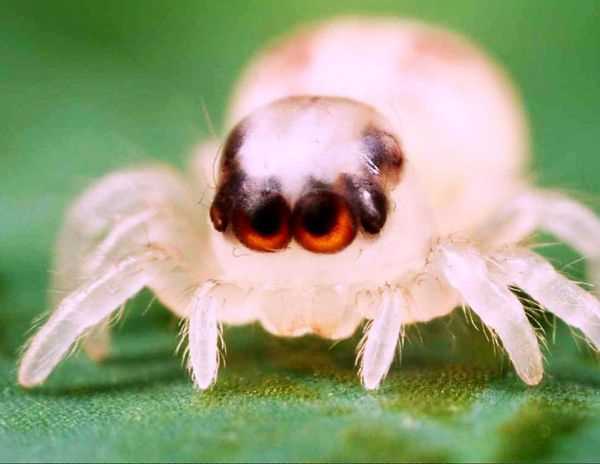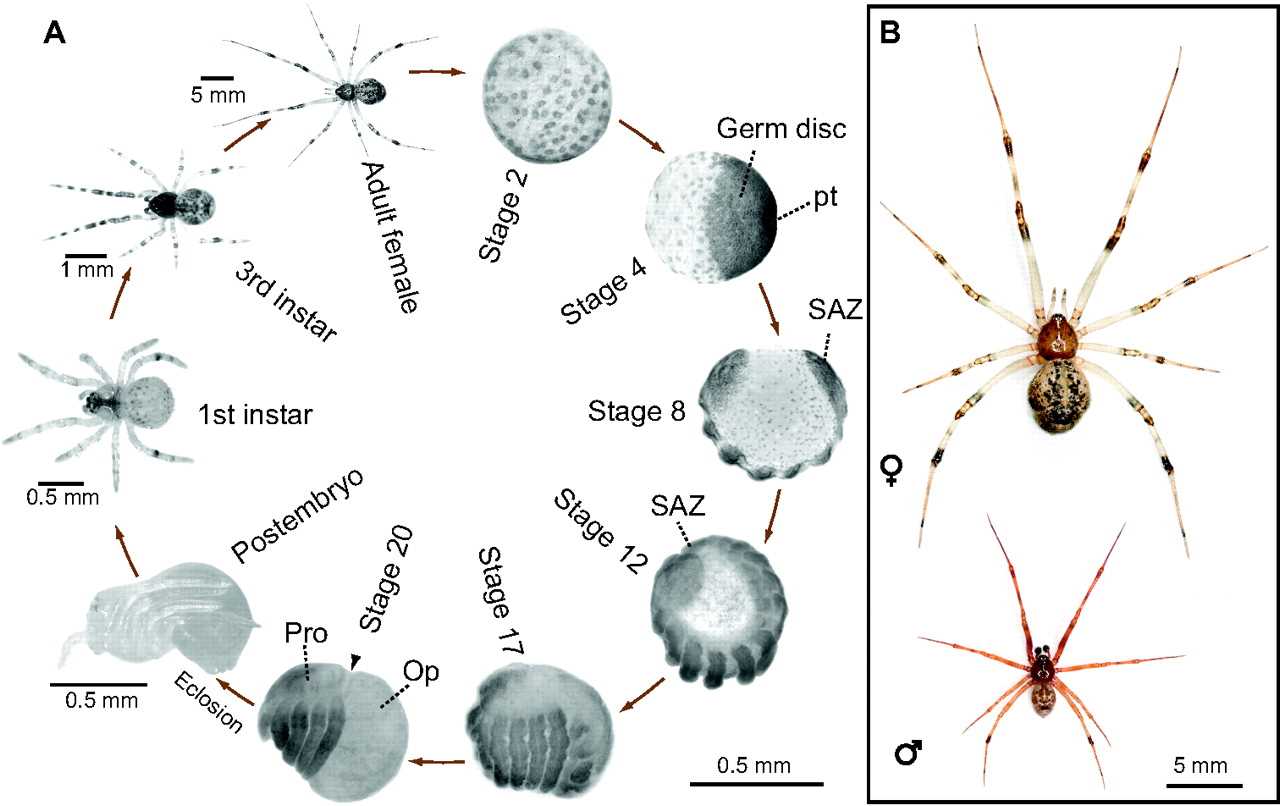During each instar, the jumping spider undergoes significant growth and transformation. The classification is based on the number of times the spider has molted, shedding its exoskeleton to accommodate its increasing size. Each instar is marked by distinctive features, such as coloration and body shape, which help identify the stage of development.
What are Instars?
During each instar, the spider undergoes physical changes, including increases in size and changes in body structure. These changes are vital for the spider’s survival and adaptation to its environment.
The growth of a spider can be divided into several instar stages. In the case of jumping spiders, there are typically several instar stages before the spider reaches adulthood.
A helpful tool in studying instars is an instar chart. This chart provides a visual representation of the various instar stages, allowing researchers to track the progress of individual spiders and identify key characteristics at each stage.
Life Cycle of Jumping Spiders
What are Instars?
An instar is a developmental stage in the life cycle of an arthropod, particularly insects and spiders. It is a period between molts, where the arthropod grows in size and undergoes physical changes. Each instar is characterized by a different morphology, size, and behavior. The number of instars an arthropod goes through can vary, with some species having only a few instars, while others may have several.
Jumping Spider Instar Development
With each molt, the spider’s size increases, and its coloration and patterns become more pronounced. The final instar before adulthood is often the largest and most developed. At this stage, the jumping spider has reached its mature size and displays its distinctive adult characteristics.
Differences between Jumping Spider Instars
How to Identify Jumping Spider Instars
Identifying a jumping spider’s instar can be challenging, particularly for non-experts. However, there are certain characteristics that can aid in differentiation. Size is one important factor, as each instar is larger than the previous one. Additionally, examining the coloration and patterns can provide clues to the spider’s instar. Close observation and comparison with reference materials or expert guidance are necessary for accurate identification.
Instar Chart for Jumping Spiders
An instar chart for jumping spiders can be a valuable resource for researchers, enthusiasts, and anyone interested in studying these fascinating creatures. The chart would provide information on each instar, including their size, characteristics, and distinguishing features. It would serve as a visual guide to help identify the different instars and understand their developmental progression.
Table 1 below showcases a hypothetical instar chart for jumping spiders:
| Instar | Size | Characteristics |
|---|---|---|
| First Instar | Very small | Lacks developed coloration/patterns |
| Second Instar | Small | Some coloration/patterns starting to appear |
| Third Instar | Medium | Coloration/patterns becoming more distinct |
| Fourth Instar | Large | Well-developed coloration/patterns |
| Fifth Instar | Largest | Displays adult characteristics |
Jumping spider instars can vary in size, depending on the species. Some species have smaller instars with less noticeable differences between stages, while others have more pronounced changes in size and appearance. For example, the bold jumper (Salticus scenicus) has five instars, with each instar being larger than the previous one.
To better understand the development of jumping spiders, researchers have created instar charts. These charts provide a visual representation of the different stages and help identify the instar a spider belongs to based on its size and appearance. By referencing the instar chart, scientists can accurately determine the developmental stage of a jumping spider.
Differences between Jumping Spider Instars

Another important difference between instars is in their physical appearance. While all jumping spider instars share a similar body plan, there are often subtle differences in coloration and markings that can help identify the stage of development. These differences can be particularly useful when trying to determine the age of a jumping spider.
| Instar | Size | Physical Appearance | Behavior | Hunting Strategy |
|---|---|---|---|---|
| 1st | Small | Light coloration, minimal markings | Cautious, less aggressive | Ambush |
| 2nd | Medium | Slightly darker coloration | Increasing confidence, slightly more aggressive | Ambush |
| 3rd | Large | Distinct markings, more vibrant colors | Confident, moderately aggressive | Stalk and ambush |
| 4th | Extra large | Elaborate markings, bright colors | Highly confident, aggressive | Web weaving and stalking |
How to Identify Jumping Spider Instars
Jumping spiders go through several stages of growth called instars before reaching adulthood. Each instar represents a different size and level of development in the spider’s life cycle. To identify jumping spider instars, you can refer to an instar chart or observe their physical characteristics.
Jumping Spider Instar Chart
A jumping spider instar chart provides a visual classification of the different stages of development in jumping spiders. It typically includes images and descriptions of each instar, indicating their size, coloration, and other distinguishing features. By comparing a spider’s appearance to the chart, you can determine its current instar and track its growth progress.
Observing Physical Characteristics
Another way to identify jumping spider instars is by observing their physical characteristics. Each instar has distinct traits that can help differentiate it from others. These characteristics may include body size, color patterns, eye arrangement, and leg proportions.
As jumping spiders grow and molt, their physical appearance changes, and they acquire new features unique to each instar. By carefully examining these traits, you can identify the specific instar a spider belongs to.
Using a Table for Identification

Creating a table to document the key characteristics of each jumping spider instar can be a helpful tool for identification purposes. The table should include columns for characteristics such as body size, coloration, eye arrangement, leg proportions, and any other distinctive features.
| Instar | Body Size | Coloration | Eye Arrangement | Leg Proportions | Distinctive Features |
|---|---|---|---|---|---|
| First Instar | 1-2mm | Pale or translucent | Eyes close together | Short legs | N/A |
| Second Instar | 2-3mm | More pigmentation | Eyes slightly apart | Legs lengthen | Slightly bigger body |
| Third Instar | 3-4mm | More pronounced coloration | Eyes more apart | Legs elongate | Increased body size |
By referring to this table and comparing the spider’s characteristics to the corresponding instar, you can accurately identify the jumping spider’s current stage of development.
Instar Chart for Jumping Spiders
Jumping spiders go through several growth stages called instars as part of their development. Each instar represents a different stage in the life cycle of these arachnids. The main characteristic that distinguishes one instar from another is size.
Jumping spider instars can be identified by referring to an instar chart. This chart provides information about the size and appearance of each instar, allowing researchers and enthusiasts to accurately identify and study these spiders.
| Instar | Size | Appearance |
|---|---|---|
| First Instar | Very small | Resemble miniature adults |
| Second Instar | Slightly larger | Develop more distinct markings |
| Third Instar | Medium-sized | Show more vibrant coloration |
| Fourth Instar | Larger | Markings become more pronounced |
| Fifth Instar | Almost adult size | Appearance similar to adults but with some differences |
| Adult | Full size | Distinctive adult markings and features |
Overall, the instar chart for jumping spiders is an essential tool for anyone interested in studying or appreciating these unique arachnids. It provides valuable insights into the growth and development of jumping spider instars, allowing us to better understand and appreciate the diversity and complexity of these remarkable creatures.
Jumping spiders are fascinating arachnids that undergo a remarkable process of growth and development. To better understand their life cycle, scientists have devised a classification system called instars, which helps track the stages of a spider’s growth and development.
What are Instars?
Instars refer to the developmental stages in the life cycle of a jumping spider. These stages identify the different phases a spider goes through as it matures from a newly hatched spiderling to a fully grown adult. Each instar is characterized by distinct physical characteristics and behaviors.
Life Cycle of Jumping Spiders
The life cycle of jumping spiders typically consists of multiple instars. After hatching from an egg sac, the spider goes through several molts, shedding its exoskeleton and growing in the process. Each molt marks the transition to a new instar, bringing the spider closer to adulthood.
Jumping Spider Instar Development
Differences between Jumping Spider Instars
How to Identify Jumping Spider Instars
Instar Chart for Jumping Spiders
An important tool in the study of jumping spider instars is the instar chart. This chart serves as a reference point for researchers and enthusiasts alike, providing a visual representation of the various stages of a spider’s growth. It helps in the accurate identification and classification of jumping spider instars.
The accurate identification and classification of jumping spider instars are essential for various reasons. It allows researchers to study their growth patterns and better understand their behavior and ecology. Additionally, it helps in the development of more effective conservation strategies by providing insights into the population dynamics of different species.

I’m Lena Adams—a product of an unconventional upbringing in the African wilderness. My father, a daring explorer of African wildlife, sparked my fascination with reptiles, a passion that intertwined with the tragic loss of my mother during an expedition, leaving an indelible mark on my life. Driven to understand the creatures that captivated my parents, I embarked on my journey, sharing insights about reptiles, frogs, and lizards on my website. Through my explorations and conservation efforts, I honour my family’s legacy while seeking connections—to the creatures, nature, and the mother whose presence I yearn to understand.
